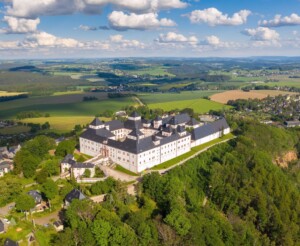As the National Trust for Historic Preservation adds the Milwaukee Domes to its “National Treasures” programme, a new study identifies ways to increase tourism.
The Mitchell Park Horticultural Conservatory (The Domes) comprises three unique cone-shaped glasshouses. The Domes are part of the oldest park in the Milwaukee Parks system, sited above the Menomonee Valley.
Greater Boston-based ConsultEcon has created a report, The Future Path Feasibility Study, which shows how the 50-year old Domes could attract more visitors and better serve the broader community’s needs. The report shows a future vision for the attraction, pinpointing ways the conservatory could improve its impact through smarter operations, marketing and programming.
Robert E. Brais, vice president of ConsultEcon presented a report at the December meeting of the Mitchell Park Conservatory Task Force, which comprises both county officials and local citizens.
He said that, even without major marketing, The Domes are the fifth most popular attraction in Metropolitan Milwaukee. The conservatory had 210,000 visitors in 2015, trailing only the Milwaukee County Zoo, Milwaukee Public Museum, Discovery World and the Milwaukee Art Museum.
The Domes also attract that attendance with very few employees — the highest ratio among local attractions (16,154 attendees per each of its 13 full-time-equivalent employees). In comparison, the Milwaukee County Zoo attracts 3,714 attendees per FTE. It also receives much more budgetary support from the county.
However the report believes The Domes could dramatically increase attendance through targeted investments. Many options “would not be huge undertakings but could make a big difference,” said Brais. These might include high-quality changing exhibits and interpretative displays. He also talked about the integration of science, technology, engineering, art and math (STEAM) education within the conservatory’s programming.
Broader-ranging options include transforming the current “show dome” into a third climate-exhibit space. A canopy-walk structure was also suggested alongside the return of botanical gardens. Night-time educational events were also mooted. A visitor orientation/theatre area and food-service facilities would ideally be created.
Brais pointed out that the major plans would require “significant private/philanthropic capital funding for implementation” but that, in turn, they would offer major benefits to the community and bring economic development. Enhanced amenities would support longer visits and drive attendance.
Partnerships with local institutions could broaden audience appeal. Brais suggested these could range from shared use of facilities, through sponsorships, to a permanent organisational merger. “Determine your vision first, and then enlist partners who you might help to achieve that vision,” said Brais. He said that increased staffing, branding and advertising could help sustain long-term success.
The other alternative is that the task force could recommend repurposing the Domes for other uses. They could even suggest razing them and reusing the site.
Image: Milwaukee Preservation Alliance
Report: The Domes Could be Attracting Many More Visitors Than it Is













